Satwik Kottur
Continual Dialogue State Tracking via Example-Guided Question Answering
May 23, 2023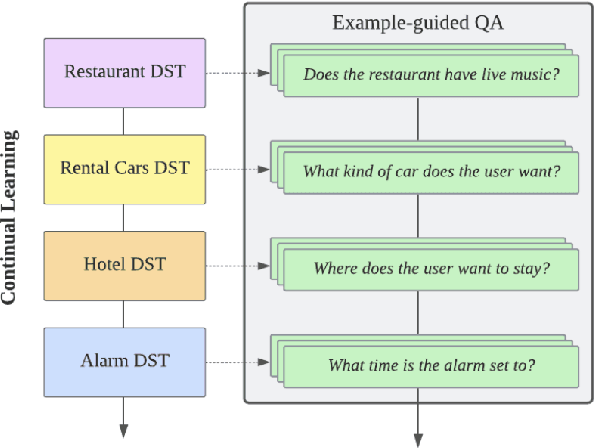
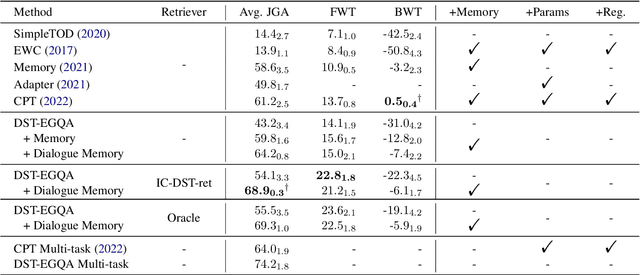
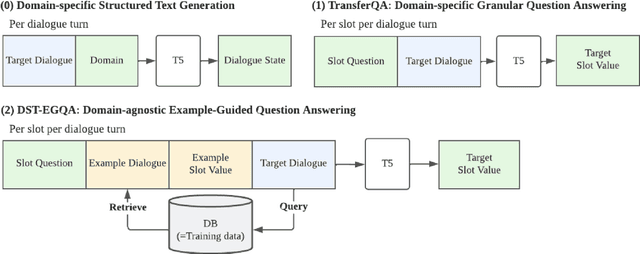
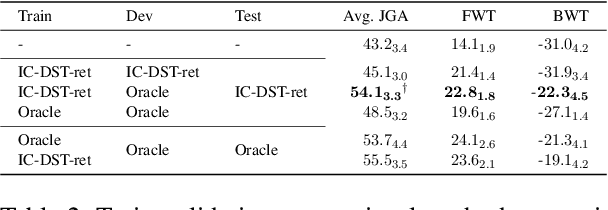
Abstract:Dialogue systems are frequently updated to accommodate new services, but naively updating them by continually training with data for new services in diminishing performance on previously learnt services. Motivated by the insight that dialogue state tracking (DST), a crucial component of dialogue systems that estimates the user's goal as a conversation proceeds, is a simple natural language understanding task, we propose reformulating it as a bundle of granular example-guided question answering tasks to minimize the task shift between services and thus benefit continual learning. Our approach alleviates service-specific memorization and teaches a model to contextualize the given question and example to extract the necessary information from the conversation. We find that a model with just 60M parameters can achieve a significant boost by learning to learn from in-context examples retrieved by a retriever trained to identify turns with similar dialogue state changes. Combining our method with dialogue-level memory replay, our approach attains state of the art performance on DST continual learning metrics without relying on any complex regularization or parameter expansion methods.
Hierarchical Video-Moment Retrieval and Step-Captioning
Mar 29, 2023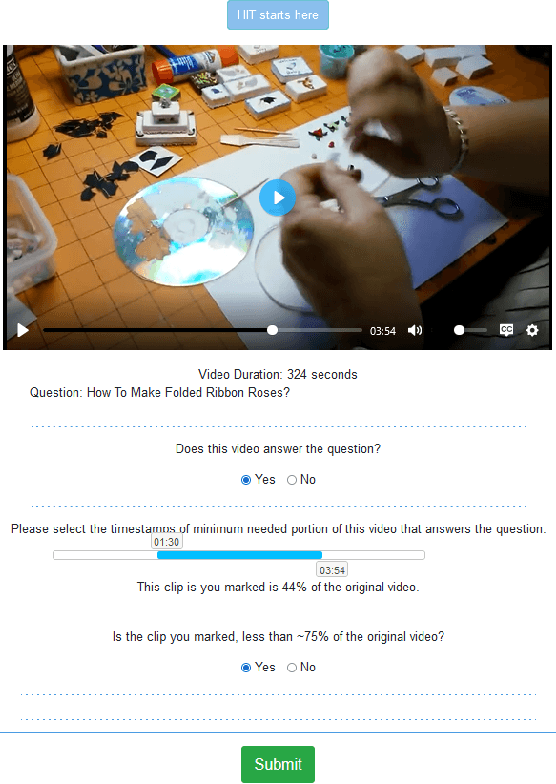

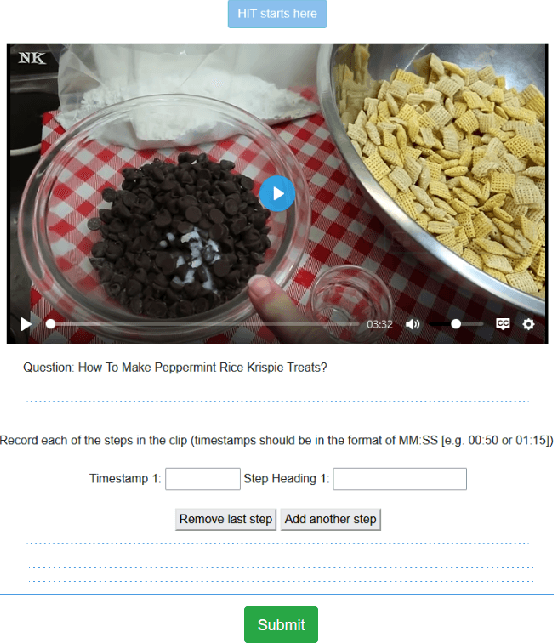
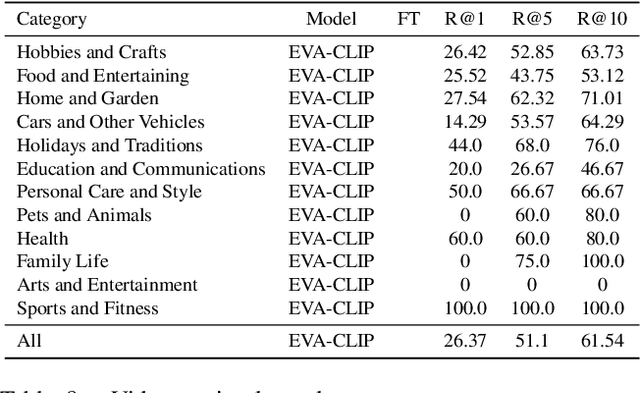
Abstract:There is growing interest in searching for information from large video corpora. Prior works have studied relevant tasks, such as text-based video retrieval, moment retrieval, video summarization, and video captioning in isolation, without an end-to-end setup that can jointly search from video corpora and generate summaries. Such an end-to-end setup would allow for many interesting applications, e.g., a text-based search that finds a relevant video from a video corpus, extracts the most relevant moment from that video, and segments the moment into important steps with captions. To address this, we present the HiREST (HIerarchical REtrieval and STep-captioning) dataset and propose a new benchmark that covers hierarchical information retrieval and visual/textual stepwise summarization from an instructional video corpus. HiREST consists of 3.4K text-video pairs from an instructional video dataset, where 1.1K videos have annotations of moment spans relevant to text query and breakdown of each moment into key instruction steps with caption and timestamps (totaling 8.6K step captions). Our hierarchical benchmark consists of video retrieval, moment retrieval, and two novel moment segmentation and step captioning tasks. In moment segmentation, models break down a video moment into instruction steps and identify start-end boundaries. In step captioning, models generate a textual summary for each step. We also present starting point task-specific and end-to-end joint baseline models for our new benchmark. While the baseline models show some promising results, there still exists large room for future improvement by the community. Project website: https://hirest-cvpr2023.github.io
Navigating Connected Memories with a Task-oriented Dialog System
Nov 15, 2022



Abstract:Recent years have seen an increasing trend in the volume of personal media captured by users, thanks to the advent of smartphones and smart glasses, resulting in large media collections. Despite conversation being an intuitive human-computer interface, current efforts focus mostly on single-shot natural language based media retrieval to aid users query their media and re-live their memories. This severely limits the search functionality as users can neither ask follow-up queries nor obtain information without first formulating a single-turn query. In this work, we propose dialogs for connected memories as a powerful tool to empower users to search their media collection through a multi-turn, interactive conversation. Towards this, we collect a new task-oriented dialog dataset COMET, which contains $11.5k$ user<->assistant dialogs (totaling $103k$ utterances), grounded in simulated personal memory graphs. We employ a resource-efficient, two-phase data collection pipeline that uses: (1) a novel multimodal dialog simulator that generates synthetic dialog flows grounded in memory graphs, and, (2) manual paraphrasing to obtain natural language utterances. We analyze COMET, formulate four main tasks to benchmark meaningful progress, and adopt state-of-the-art language models as strong baselines, in order to highlight the multimodal challenges captured by our dataset.
Tell Your Story: Task-Oriented Dialogs for Interactive Content Creation
Nov 08, 2022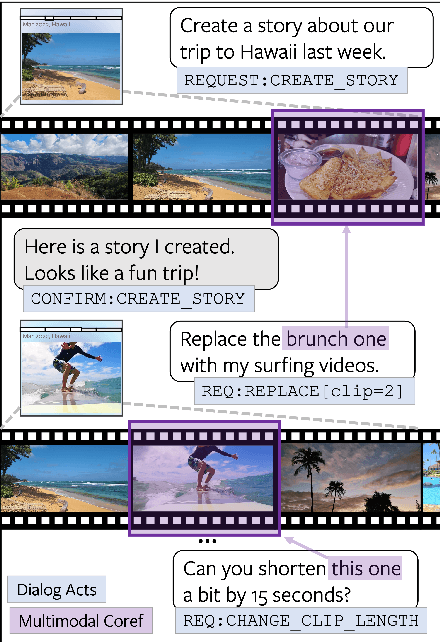
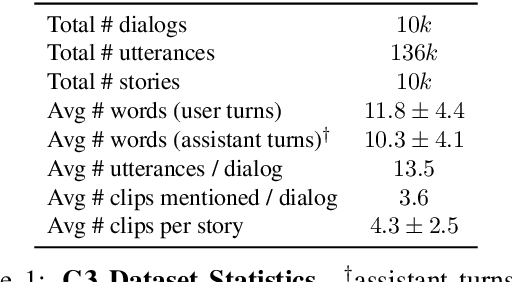


Abstract:People capture photos and videos to relive and share memories of personal significance. Recently, media montages (stories) have become a popular mode of sharing these memories due to their intuitive and powerful storytelling capabilities. However, creating such montages usually involves a lot of manual searches, clicks, and selections that are time-consuming and cumbersome, adversely affecting user experiences. To alleviate this, we propose task-oriented dialogs for montage creation as a novel interactive tool to seamlessly search, compile, and edit montages from a media collection. To the best of our knowledge, our work is the first to leverage multi-turn conversations for such a challenging application, extending the previous literature studying simple media retrieval tasks. We collect a new dataset C3 (Conversational Content Creation), comprising 10k dialogs conditioned on media montages simulated from a large media collection. We take a simulate-and-paraphrase approach to collect these dialogs to be both cost and time efficient, while drawing from natural language distribution. Our analysis and benchmarking of state-of-the-art language models showcase the multimodal challenges present in the dataset. Lastly, we present a real-world mobile demo application that shows the feasibility of the proposed work in real-world applications. Our code and data will be made publicly available.
Database Search Results Disambiguation for Task-Oriented Dialog Systems
Dec 15, 2021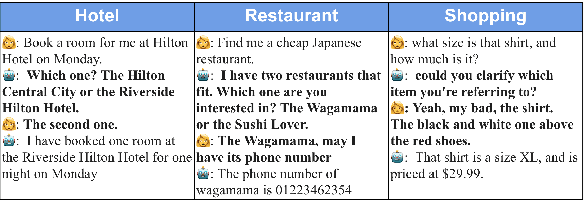

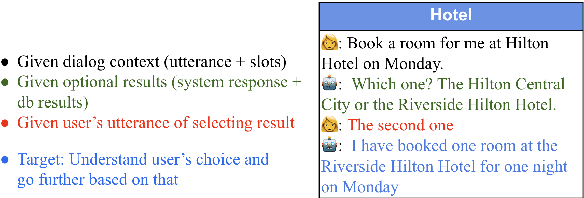

Abstract:As task-oriented dialog systems are becoming increasingly popular in our lives, more realistic tasks have been proposed and explored. However, new practical challenges arise. For instance, current dialog systems cannot effectively handle multiple search results when querying a database, due to the lack of such scenarios in existing public datasets. In this paper, we propose Database Search Result (DSR) Disambiguation, a novel task that focuses on disambiguating database search results, which enhances user experience by allowing them to choose from multiple options instead of just one. To study this task, we augment the popular task-oriented dialog datasets (MultiWOZ and SGD) with turns that resolve ambiguities by (a) synthetically generating turns through a pre-defined grammar, and (b) collecting human paraphrases for a subset. We find that training on our augmented dialog data improves the model's ability to deal with ambiguous scenarios, without sacrificing performance on unmodified turns. Furthermore, pre-fine tuning and multi-task learning help our model to improve performance on DSR-disambiguation even in the absence of in-domain data, suggesting that it can be learned as a universal dialog skill. Our data and code will be made publicly available.
DAIR: Data Augmented Invariant Regularization
Oct 21, 2021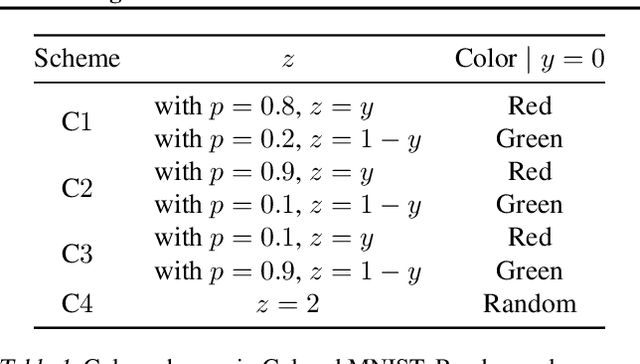
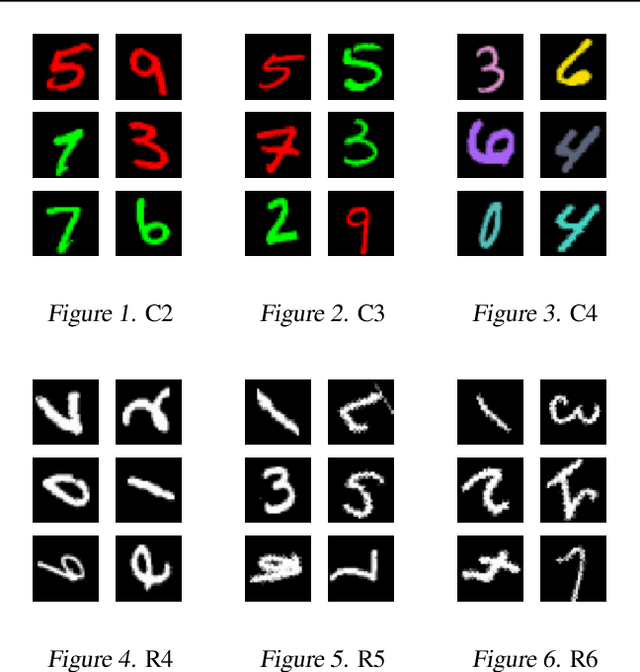
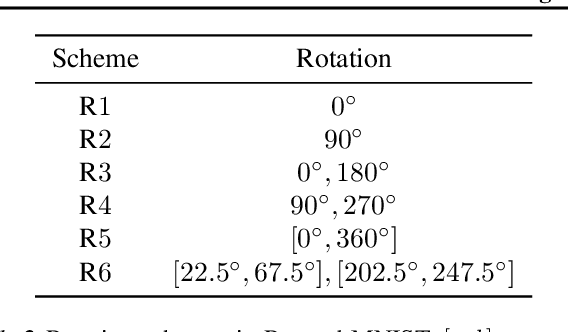
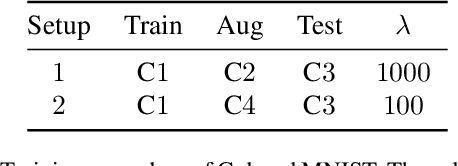
Abstract:While deep learning through empirical risk minimization (ERM) has succeeded at achieving human-level performance at a variety of complex tasks, ERM generalizes poorly to distribution shift. This is partly explained by overfitting to spurious features such as background in images or named entities in natural language. Synthetic data augmentation followed by empirical risk minimization (DA-ERM) is a simple yet powerful solution to remedy this problem. In this paper, we propose data augmented invariant regularization (DAIR). The idea of DAIR is based on the observation that the model performance (loss) is desired to be consistent on the augmented sample and the original one. DAIR introduces a regularizer on DA-ERM to penalize such loss inconsistency. Both theoretically and through empirical experiments, we show that a particular form of the DAIR regularizer consistently performs well in a variety of settings. We apply it to multiple real-world learning problems involving domain shift, namely robust regression, visual question answering, robust deep neural network training, and task-oriented dialog modeling. Our experiments show that DAIR consistently outperforms ERM and DA-ERM with little marginal cost and setting new state-of-the-art results in several benchmarks.
Ego4D: Around the World in 3,000 Hours of Egocentric Video
Oct 13, 2021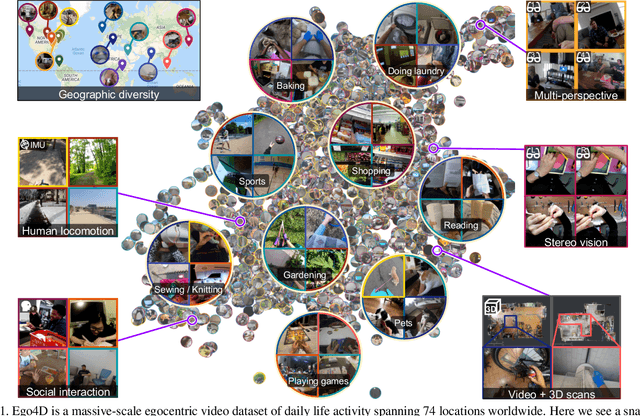
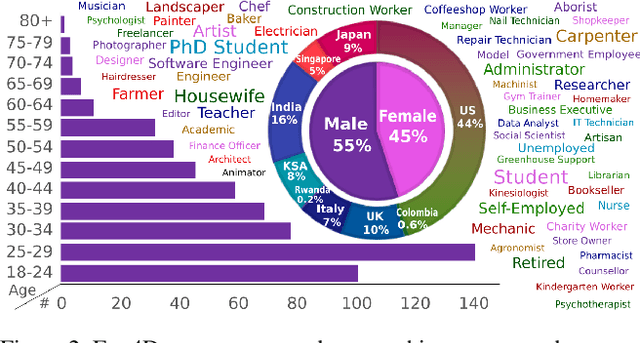

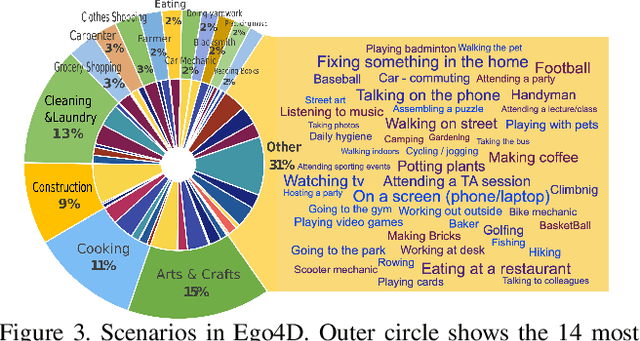
Abstract:We introduce Ego4D, a massive-scale egocentric video dataset and benchmark suite. It offers 3,025 hours of daily-life activity video spanning hundreds of scenarios (household, outdoor, workplace, leisure, etc.) captured by 855 unique camera wearers from 74 worldwide locations and 9 different countries. The approach to collection is designed to uphold rigorous privacy and ethics standards with consenting participants and robust de-identification procedures where relevant. Ego4D dramatically expands the volume of diverse egocentric video footage publicly available to the research community. Portions of the video are accompanied by audio, 3D meshes of the environment, eye gaze, stereo, and/or synchronized videos from multiple egocentric cameras at the same event. Furthermore, we present a host of new benchmark challenges centered around understanding the first-person visual experience in the past (querying an episodic memory), present (analyzing hand-object manipulation, audio-visual conversation, and social interactions), and future (forecasting activities). By publicly sharing this massive annotated dataset and benchmark suite, we aim to push the frontier of first-person perception. Project page: https://ego4d-data.org/
SIMMC 2.0: A Task-oriented Dialog Dataset for Immersive Multimodal Conversations
Apr 18, 2021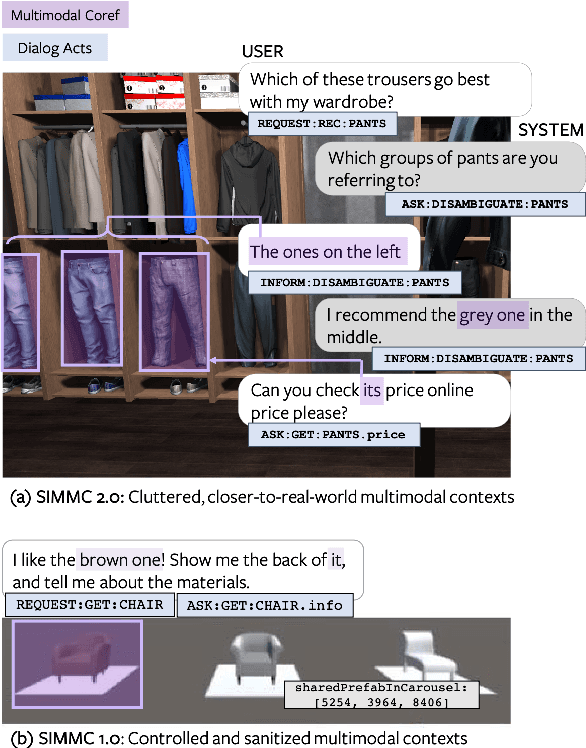



Abstract:We present a new corpus for the Situated and Interactive Multimodal Conversations, SIMMC 2.0, aimed at building a successful multimodal assistant agent. Specifically, the dataset features 11K task-oriented dialogs (117K utterances) between a user and a virtual assistant on the shopping domain (fashion and furniture), grounded in situated and photo-realistic VR scenes. The dialogs are collected using a two-phase pipeline, which first generates simulated dialog flows via a novel multimodal dialog simulator we propose, followed by manual paraphrasing of the generated utterances. In this paper, we provide an in-depth analysis of the collected dataset, and describe in detail the four main benchmark tasks we propose for SIMMC 2.0. The preliminary analysis with a baseline model highlights the new challenges that the SIMMC 2.0 dataset brings, suggesting new directions for future research. Our dataset and code will be made publicly available.
DVD: A Diagnostic Dataset for Multi-step Reasoning in Video Grounded Dialogue
Jan 01, 2021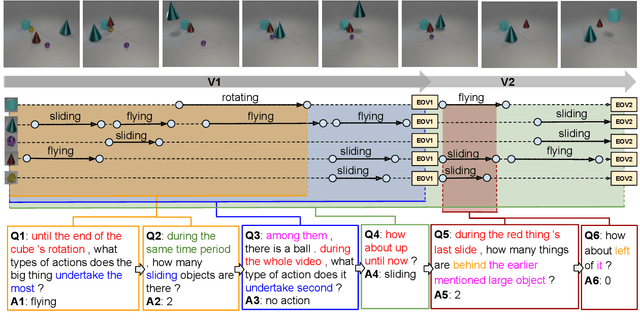
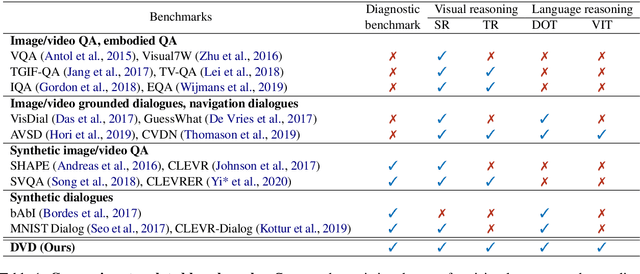

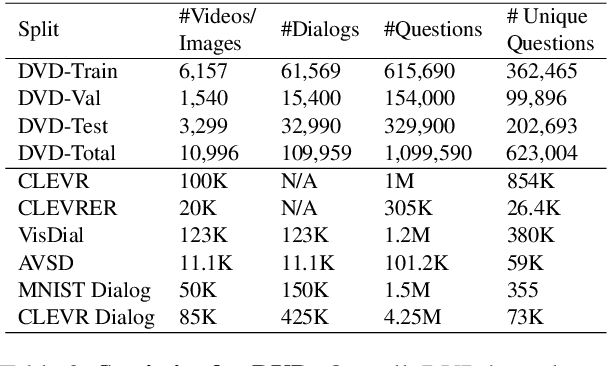
Abstract:A video-grounded dialogue system is required to understand both dialogue, which contains semantic dependencies from turn to turn, and video, which contains visual cues of spatial and temporal scene variations. Building such dialogue systems is a challenging problem involving complex multimodal and temporal inputs, and studying them independently is hard with existing datasets. Existing benchmarks do not have enough annotations to help analyze dialogue systems and understand their linguistic and visual reasoning capability and limitations in isolation. These benchmarks are also not explicitly designed to minimize biases that models can exploit without actual reasoning. To address these limitations, in this paper, we present a diagnostic dataset that can test a range of reasoning abilities on videos and dialogues. The dataset is designed to contain minimal biases and has detailed annotations for the different types of reasoning each question requires, including cross-turn video interval tracking and dialogue object tracking. We use our dataset to analyze several dialogue system approaches, providing interesting insights into their abilities and limitations. In total, the dataset contains $10$ instances of $10$-round dialogues for each of $\sim11k$ synthetic videos, resulting in more than $100k$ dialogues and $1M$ question-answer pairs. Our code and dataset will be made public.
Overview of the Ninth Dialog System Technology Challenge: DSTC9
Nov 12, 2020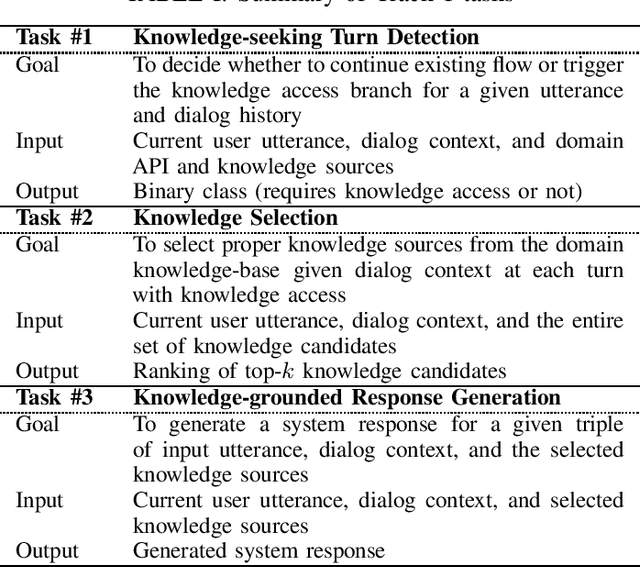


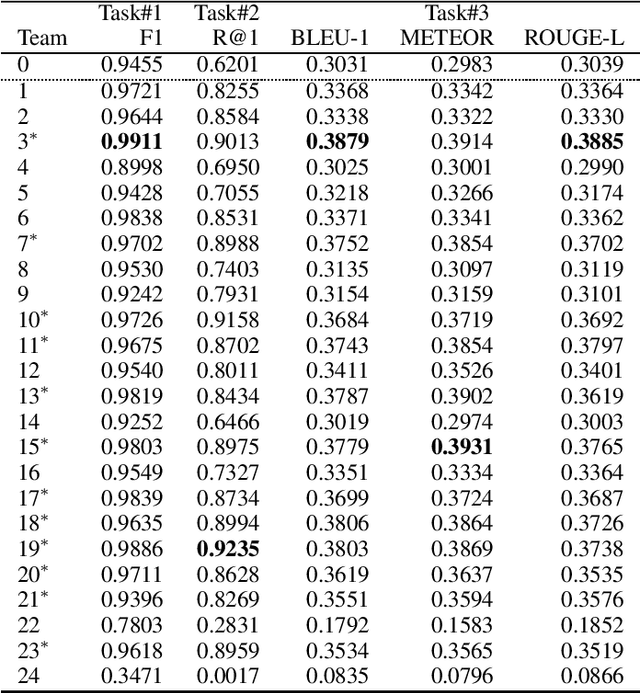
Abstract:This paper introduces the Ninth Dialog System Technology Challenge (DSTC-9). This edition of the DSTC focuses on applying end-to-end dialog technologies for four distinct tasks in dialog systems, namely, 1. Task-oriented dialog Modeling with unstructured knowledge access, 2. Multi-domain task-oriented dialog, 3. Interactive evaluation of dialog, and 4. Situated interactive multi-modal dialog. This paper describes the task definition, provided datasets, baselines and evaluation set-up for each track. We also summarize the results of the submitted systems to highlight the overall trends of the state-of-the-art technologies for the tasks.
 Add to Chrome
Add to Chrome Add to Firefox
Add to Firefox Add to Edge
Add to Edge